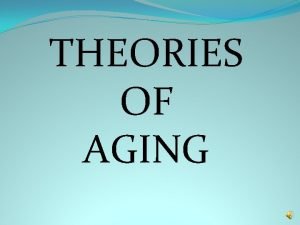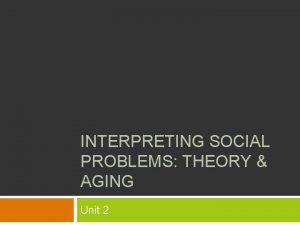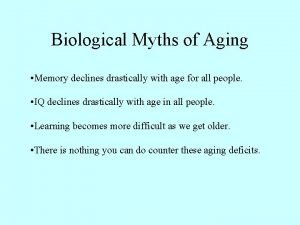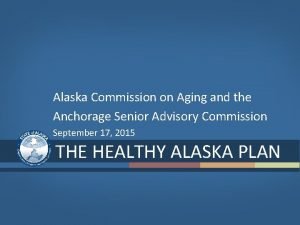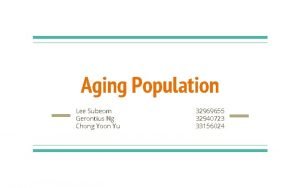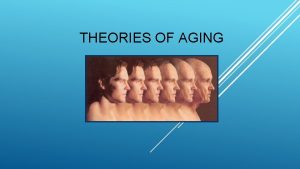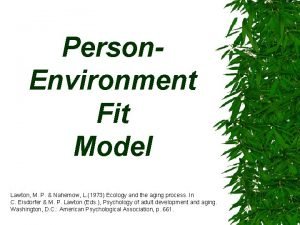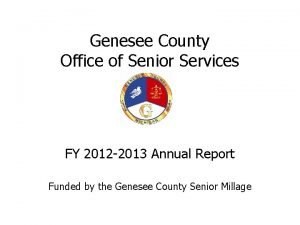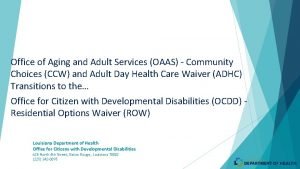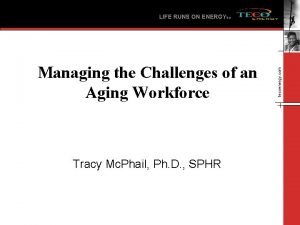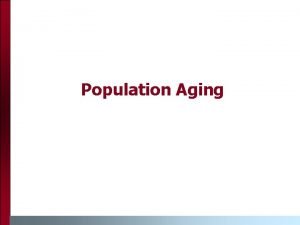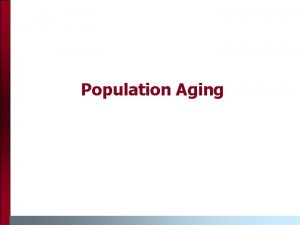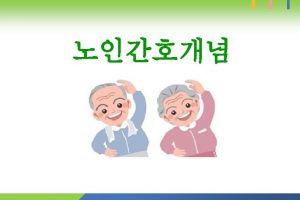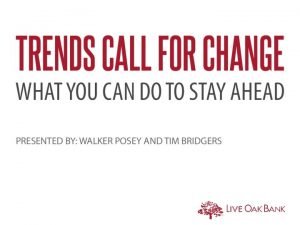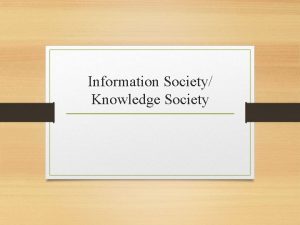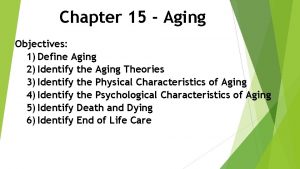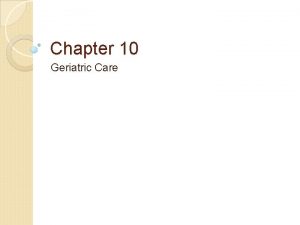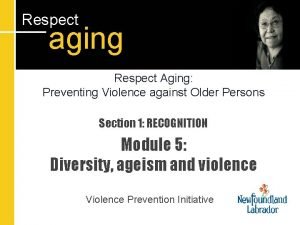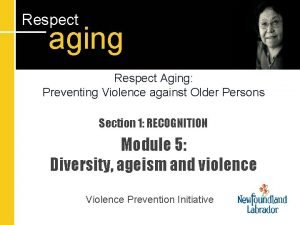An Aging Society Chapter 9 Aging as a
































- Slides: 32

An Aging Society Chapter 9

Aging as a Social Problem • Aging places stress on the individual and society • Long term failure of social institutions to accommodate the elderly • Failure of the family to adapt to presence of older members • Strain on the labor force as careers of the young are blocked by those in their middle years

Aging as a Social Problem • Three factors are related to some of the problems of the aged • 1. Labeling, which leads to discrimination and stigmatization of the elderly • 2. The concept of work as the basis of personal value and the impact of retirement • 3. Economic deprivation

Perspectives on Aging • Functionalists view aging as a problem because institutions of society are not working well enough to serve the needs of an aging population • Interactionists view the term elderly as a stigmatizing label (ageism) that negatively impacts the elderly in society • Conflict theorists view the problems of the elderly stemming from their lack of power to shape social institutions

The Elderly in America Today • Problems of the elderly today are tied to the process of modernization • The transformation of societies into complex urban and industrialized communities • Modernization has led to increased life expectancy » Medical advances » Modern techniques of sanitation and water supply and nutritional intake

The Elderly in America Today • Increased life expectancy has also led to more major health problems among the elderly • Urbanization has also led to a shift in the elderly population geographically » Rural elderly in the Midwest and Plains states » Movement of the elderly to Florida and the Southwest

Age Stratification • Age stratification – the segregation of the population into various age strata • Limits the roles of different age strata • Age stratification is related to some of the disengagement of the elderly from certain social roles » Work roles as an illustration

Age Stratification • Age stratification is also related to age segregation and conflict » Segregated into retirement communities • Intergenerational conflict

Who Are the Elderly? • The elderly are a diverse population often broken down into three groups • Young-old - those between the ages of 65 to 75 » Still inclined to be healthy and active • Steady increase in the population over 65 over the next generation » Aging of the baby boom generation • Old-old - those over 75 » More likely to require support services

Who Are the Elderly? • Oldest-old - those over the age of 85 • Frail elderly consist of those over 65 because of poor health and economic problems can not care for themselves without help • Two-thirds of the elderly live in urban areas • The elderly often represent a large portion of the population of small towns with out-migration of the young • Elderly migration to the West and South and the formation of retirement communities

Who Are the Elderly? • The Uneven Graying of America • The 2000 census revealed that the elderly population is continuing to grow rapidly, it is not evenly distributed over the continent • During the last decade, the most rapid increases in the elderly population were among the oldest of the old, those over 85

Ageism • Ageism is the subordination of and devaluation of the elderly in society • Ageism is reflected in government » Administration on Aging has low status within government » Aging departments are often the subject of budget cuts during lean times

Ageism • Ageism is reflected in mandatory retirement » Loss of status » Economic security » Social isolation • Ageism is reflected in the media » Negative portrayal of the elderly • Ageism is also reflected in the high rate of suicide among the elderly

Ageism • Ageism is also reflected in the high rate of suicide among the elderly • Suicide among the elderly is related to » Loss of status and income » Poor health » Loss of friend and family relationships and social isolation

Dimensions of the Aging Process • Physiological Aspects of Aging • Chronological Aging - simple accumulation of years • Gerontology has emerged as a discipline concerned with studying the aging process

Dimensions of the Aging Process • Physiological Aspects of Aging • Primary and secondary aging • Primary aging is the result of molecular and cellular changes » Gray hair » Wrinkling of skin » Weakened immune system » Brain cell loss

Dimensions of the Aging Process • Physiological Aspects of Aging • Primary and secondary aging • Secondary aging is caused by environmental factors: » Lack of exercise » Stress » Trauma » Poor diet » Disease

Dimensions of the Aging Process • • • Physiological Aspects of Aging Primary and secondary aging Aging is a gradual process Carries a personal timetable Effects of aging are not inevitable Preventative strategies can be used to slow the aging process

Dimensions of the Aging Process • Psychological Dimensions of Aging • The psychological effects of aging • The shrinking of one’s social environment » Self-concept » Loss of status » Circle of friends and family grow smaller • The negative label associated with aging impacts the elderly’s well-being

Dimensions of the Aging Process • Social and Cultural Dimensions of Aging • The Aged as a Minority Group • Victims of prejudice, stereotyping, and discrimination • Quasi-minority » Potential power of the elderly is enormous

Dimensions of the Aging Process • Social and Cultural Dimensions of Aging • Myths and Stereotypes About the Elderly • The elderly are often viewed as » Senile » Lacking individuality » Tranquil » Nonproductive » Conservative and resistant to change

Dimensions of the Aging Process • • • Social and Cultural Dimensions of Aging Myths and Stereotypes About the Elderly Myths about older women Health - older women are hypochondriacs Marriage - widowhood is viewed negatively Widowhood - widows base their identities on their dead husbands • The rocking-chair image

Concomitants of Aging • • Victimization of the Elderly Victims of fraud Victims of crime Elder Abuse At least 1. 5 million cases of elder abuse each year Private households Institutional settings

Concomitants of Aging • Health Care and the Aged • Chronic illnesses • Growing health care needs and lack of income to afford it • Medicare • Medicaid, of which 35 percent goes towards the elderly

Concomitants of Aging • Economic Discrimination • Older workers are targets of job discrimination » Mandatory retirement • Discrimination in looking for jobs » Overqualified • 1967 Age and Discrimination Employment Act » Prohibits discrimination of workers between the age of 40 -65

Concomitants of Aging • Economic Discrimination • Multiple Jeopardy • Minority workers often experience double discrimination • Family Problems • Institutional placement is often a difficult decision • A growing number of elderly people are facing the burden of rearing their grandchildren

Concomitants of Aging • Retirement and the dependency ratio » Non working population that is dependent on those that are working for support • Dependency ratio and the cost of: » Medicare » Social Security

Concomitants of Aging • • Death Kübler-Ross and the dying process: 1. Denial and isolation 2. Anger and resentment 3. Bargaining and an attempt to postpone death 4. Depression and a sense of loss 5. Acceptance

Concomitants of Aging • Death • Hospice - special institutions designed for the terminally ill • Home hospice care • Death with Dignity

Social Policy • Housing • Living alone and dealing with isolation and loneliness • Elderly who live with their adult children or relatives do so for financial reasons or declining health • Elderly face limited housing choices

Social Policy • Health Care • Growing elderly population in need of health care » Medicare and growing cost • Long-term care • Subsidies for prescription drugs

Social Policy • Retirement and Social Security • Social Security benefits are too small for the purposes these subsidies meet • Inequality and social security payments » Low-income workers receive less » Discriminates against women
 Gertler econ
Gertler econ Chapter 10:2 physical changes of aging
Chapter 10:2 physical changes of aging Garontology
Garontology George carlin philosophy for old age
George carlin philosophy for old age Which of the following market from
Which of the following market from Problems with conflict theory
Problems with conflict theory Aging algorithm page replacement
Aging algorithm page replacement Non stochastic theory of aging
Non stochastic theory of aging Conclusion of aging
Conclusion of aging Dr berg how to look younger
Dr berg how to look younger Alaska commission on aging
Alaska commission on aging Subeom
Subeom Aging aircraft solutions
Aging aircraft solutions Continuity theory
Continuity theory National hispanic council on aging
National hispanic council on aging Fantasy makeup definition
Fantasy makeup definition Jessie emily schofield poem and on aging comparison
Jessie emily schofield poem and on aging comparison Which aging empires suffered from nationalism
Which aging empires suffered from nationalism Assistant secretary for aging
Assistant secretary for aging Effects of aging on the integumentary system
Effects of aging on the integumentary system Wisconsin institute for healthy aging
Wisconsin institute for healthy aging Uky disability resource center
Uky disability resource center Aging better together conference
Aging better together conference Environmental press model
Environmental press model Aging
Aging Genesee county senior services
Genesee county senior services Dane county aging and disability resource center
Dane county aging and disability resource center Aging in thailand
Aging in thailand Office of aging
Office of aging Ot
Ot Memory aging and brain maintenance
Memory aging and brain maintenance Managing the aging workforce challenges and solutions
Managing the aging workforce challenges and solutions Aging corrugated metal
Aging corrugated metal


